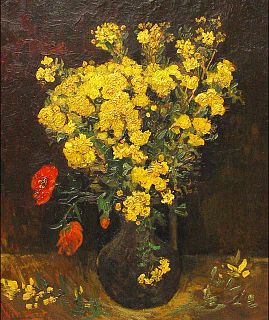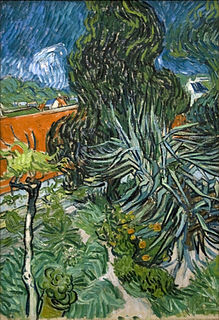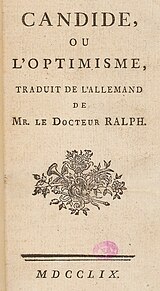
Sunflowers is the name of two series of still life paintings by the Dutch painter Vincent van Gogh. The first series, executed in Paris in 1887, depicts the flowers lying on the ground, while the second set, executed a year later in Arles, shows a bouquet of sunflowers in a vase. In the artist's mind both sets were linked by the name of his friend Paul Gauguin, who acquired two of the Paris versions. About eight months later van Gogh hoped to welcome and to impress Gauguin again with Sunflowers, now part of the painted Décoration for the Yellow House that he prepared for the guestroom of his home in Arles, where Gauguin was supposed to stay. After Gauguin's departure, van Gogh imagined the two major versions as wings of the Berceuse Triptych, and finally he included them in his Les XX in Bruxelles exhibit.

Copies by Vincent van Gogh form an important group of paintings executed by Vincent van Gogh between 1887 and early 1890. While at Saint-Paul asylum in Saint-Rémy-de-Provence, France, where Van Gogh admitted himself, he strived to have subjects during the cold winter months. Seeking to be reinvigorated artistically, Van Gogh did more than 30 copies of works by some of his favorite artists. About twenty-one of the works were copies after, or inspired by, Jean-François Millet. Rather than replicate, Van Gogh sought to translate the subjects and composition through his perspective, color, and technique. Spiritual meaning and emotional comfort were expressed through symbolism and color. His brother Theo van Gogh would call the pieces in the series some of his best work.

Flowering Orchards is a series of paintings which Dutch artist Vincent van Gogh executed in Arles, in southern France in the spring of 1888. Van Gogh arrived in Arles in February 1888 in a snowstorm; within two weeks the weather changed and the fruit trees were in blossom. Appreciating the symbolism of rebirth, Van Gogh worked with optimism and zeal on about fourteen paintings of flowering trees in the early spring. He also made paintings of flowering trees in Saint-Rémy the following year, in 1889.

The Langlois Bridge at Arles is the subject of four oil paintings, one watercolor and four drawings by Vincent van Gogh. The works, made in 1888 when Van Gogh lived in Arles, in southern France, represent a melding of formal and creative aspects. Van Gogh leverages a perspective frame that he built and used in The Hague to create precise lines and angles when portraying perspective.

Bulb Fields, also known as Flower Beds in Holland, is an oil painting created by Vincent van Gogh in early 1883. It was donated to the National Gallery of Art in Washington DC in 1983.

Poppy Flowers is a painting by Vincent van Gogh with an estimated value of $50 million to $55 million; it was stolen from Cairo's Mohamed Mahmoud Khalil Museum in August 2010 and is yet to be found.

Still Life: Vase with Pink Roses was painted in 1890 by Vincent van Gogh in Saint-Rémy. At the time the work was painted Van Gogh was readying himself to leave the Saint-Rémy asylum for the quiet town of Auvers-sur-Oise outside of Paris. The painting reflects the optimism Van Gogh felt at that time about his future, both in his choice of flowers as a subject and the colors used. The painting is owned by the National Gallery of Art of Washington, D.C.

Vincent van Gogh painted at least 15 paintings of olive trees, mostly in Saint-Rémy-de-Provence in 1889. At his own request, he lived at an asylum there from May 1889 through May 1890 painting the gardens of the asylum and, when he had permission to venture outside its walls, nearby olive trees, cypresses and wheat fields.

The Wheat Fields is a series of dozens of paintings by Vincent van Gogh, borne out of his religious studies and sermons, connection to nature, appreciation of manual laborers and desire to provide a means of offering comfort to others. The wheat field works demonstrate his progression as an artist from the drab Wheat Sheaves made in 1885 in the Netherlands to the colorful, dramatic paintings from Arles, Saint-Rémy and Auvers-sur-Oise of rural France.

Butterflies is a series paintings made by Vincent van Gogh in 1889 and 1890. Van Gogh made at least four paintings of butterflies and one of a moth. The metamorphosis of the caterpillar into a butterfly was symbolic to Van Gogh of men and women's capability for transformation.

Almond Blossoms is from a group of several paintings made in 1888 and 1890 by Vincent van Gogh in Arles and Saint-Rémy, southern France of blossoming almond trees. Flowering trees were special to van Gogh. They represented awakening and hope. He enjoyed them aesthetically and found joy in painting flowering trees. The works reflect the influence of Impressionism, Divisionism, and Japanese woodcuts. Almond Blossom was made to celebrate the birth of his nephew and namesake, son of his brother Theo and sister-in-law Jo.

Dr. Gachet's Garden in Auvers and Marguerite Gachet in the Garden were both painted in 1890 by Vincent van Gogh in the gardens of his homeopathic physician, Dr. Paul Gachet. Both paintings reside at the Musée d'Orsay.

Saint-Paul Asylum, Saint-Rémy is a collection of paintings that Vincent van Gogh made when he was a self-admitted patient at the Saint-Paul asylum in Saint-Rémy-de-Provence, since renamed the Clinique Van Gogh, from May 1889 until May 1890. During much of his stay there he was confined to the grounds of the asylum, and he made paintings of the garden, the enclosed wheat field that he could see outside his room and a few portraits of individuals at the asylum. During his stay at Saint-Paul asylum, Van Gogh experienced periods of illness when he could not paint. When he was able to resume, painting provided solace and meaning for him. Nature seemed especially meaningful to him, trees, the landscape, even caterpillars as representative of the opportunity for transformation and budding flowers symbolizing the cycle of life. One of the more recognizable works of this period is The Irises. Works of the interior of the hospital convey the isolation and sadness that he felt. From the window of his cell he saw an enclosed wheat field, the subject of many paintings made from his room. He was able to make but a few portraits while at Saint-Paul.

Hospital at Arles is the subject of two paintings that Vincent van Gogh made of the hospital in which he stayed in December 1888 and again in January 1889. The hospital is located in Arles in southern France. One of the paintings is of the central garden between four buildings titled Garden of the Hospital in Arles ; the other painting is of a ward within the hospital titled Ward of the Hospital in Arles. Van Gogh also painted a Portrait of Dr. Félix Rey his physician while in the hospital.

Portrait of Artist's Mother is an 1888 painting by Vincent van Gogh of his mother, Anna Carbentus van Gogh, drawn from a black-and-white photograph. Van Gogh's introduction to art was through his mother, herself an amateur artist. After years of strained relations with family members, Van Gogh excitedly shared some of his works he thought his mother would appreciate most, of flowers and natural settings. In this painting, Van Gogh captures his mother's dignified and proud nature.

Van Gogh's family in his art is a group of works that Vincent van Gogh made for or about Van Gogh family members. In 1881, Vincent drew a portrait of his grandfather, also named Vincent van Gogh, and his sister Wil. While living in Nuenen, Vincent memorialized his father in Still Life with Bible following his death in 1885. There he also made many paintings and drawings in 1884 and 1885 of his parent's vicarage, its garden and the church. At the height of his career in Arles he made Portrait of the Artist's Mother, Memory of the Garden at Etten of his mother and sister and Novel Reader, which is thought to be of his sister, Wil.

Still life paintings by Vincent van Gogh (Paris) is the subject of many drawings, sketches and paintings by Vincent van Gogh in 1886 and 1887 after he moved to Montmartre in Paris from the Netherlands. While in Paris, Van Gogh transformed the subjects, color and techniques that he used in creating still life paintings.

Old Vineyard with Peasant Woman is a drawing by Vincent van Gogh that he made in May 1890 when he lived in Auvers-sur-Oise, France.

Imperial Fritillaries in a Copper Vase is an oil painting on canvas created by the post-impressionist painter Vincent van Gogh in Paris, 1887. The painting is now part of the collection of the Musée d'Orsay in Paris, France. This work was made at a time of the life of Van Gogh when he first encountered influences from Impressionists and became aware of light and color, implementing it in his paintings. This painting presages some of his most famous subsequent works, and stands out from other still lifes because of the implementation of mixed techniques and complementary colors.























